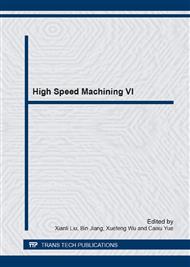p.327
p.332
p.337
p.342
p.348
p.353
p.358
p.363
p.368
Three-Dimensional Finite Element Analysis in Plunge Milling for Stainless Steel
Abstract:
The three-dimensional finite element modeling and experimental validation of plunge milling of stainless steel (1Cr13) are presented. The commercial software Deform 3D applied for the finite element modeling is studied the effect of feed rate per tooth (fz) on the cutting forces and the temperature fields. The formation of chip in the finite element model is formed by local adaptive remeshing technique. The feed rate per tooth (fz) significantly affects the cutting forces, but slightly influences the maximum temperature of the chip.
Info:
Periodical:
Pages:
348-352
Citation:
Online since:
July 2014
Authors:
Price:
Сopyright:
© 2014 Trans Tech Publications Ltd. All Rights Reserved
Share:
Citation:


